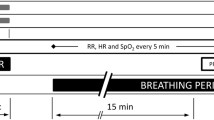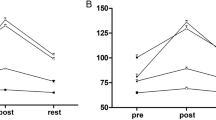Abstract
It is unclear whether exhaustive dynamic exercise increases ocular blood flow, although we have reported that submaximal exercise increases ocular blood flow. We hypothesized that ocular blood flow decreases at exhaustion, since exhaustion causes hyperventilation, which induces a reduction in PaCO2. To test this hypothesis, ocular blood flow, blood pressure, and respiratory measurements were made in 12 healthy male subjects during cycle ergometer exercise at 75% of maximal heart rate, until exhaustion. Blood flows in the retinal and choroidal vasculature (RCV), the superior temporal retinal arteriole (STRA), and the superior nasal retinal arteriole (SNRA) were measured with the aid of laser-speckle flowgraphy every 3 min during the exercise. The conductance index (CI) in the ocular vasculature was calculated by dividing the blood flow by the mean arterial pressure (MAP). The mean arterial partial pressure of CO2 (PaCO2) was estimated from tidal volume and end-tidal CO2 partial pressure. MAP significantly increased from the resting baseline throughout the exercise, while PaCO2 was significantly decreased at exhaustion and during the recovery period. By 6 min after the onset of exercise, blood flow velocity in the RCV significantly increased by 32 ± 6% (mean ± SD) from the resting baseline value. At exhaustion, blood flow velocity in the RCV did not differ significantly from the resting baseline value, and the STRA blood flow was significantly decreased by 13 ± 4%. The CIs in the RCV, STRA, and SNRA were significantly decreased compared to baseline at exhaustion. These findings suggest that ocular blood flow is increased by submaximal exercise, whereas it is suppressed by the hypocapnia associated with exhaustion.


Similar content being viewed by others
References
Alm A, Bill A (1973) Ocular and optic nerve blood flow at normal and increased intraocular pressures in monkeys (Macaca irus): a study with radioactively labeled microspheres including flow determinations in brain and some other tissue. Exp Eye Res 15(1):15–29
Bill A (1975) Blood circulation and fluid dynamics in the eye. Physol Rev 55(3):383–417
Delaey C, Van De Voorde J (2000) Regulatory mechanisms in the retinal and choroidal circulation. Ophthalmic Res 32(6):249–256
Dumsky MJ, Eriksen JE, Doré CJ, Kohner EM (1996) Autoregulation in the human retinal circulation: assessment using isometric exercise, laser Doppler velocimetry, and computer assisted image analysis. Microvasc Res 51:378–392
Eperon G, Johnson M, David NJ (1975) The effect of arterial pO2 on relative retinal blood flow in monkeys. Invest Ophthalmol 14(5):342–352
Ferrari-Dileo G, Davis EB, Anderson DR (1989) Biochemical evidence for cholinergic activity in retinal blood vessels. Invest Ophthalmol Vis Sci 30:473–477
Fujii H, Nohira K, Yamamoto Y, Ikawa H, Ohura T (1987) Evaluation of blood flow by laser speckle image sensing. Part 1. Appl Opt 26(24):5321–5325
Galy O, Hue O, Boussana A, Peyreigne C, Couret I, Gallais DL, Mercier J, Prefaut C (2003) Effects of the order of running and cycling of similar intensity and duration on pulmonary diffusing capacity in triathletes. Eur J Appl Physiol 90:489–495
Geiser MH, Riva CE, Dorner GT, Diermann U, Luksch A, Schmetterer L (2000) Response of choroidal blood flow in the foveal region to hyperoxia and hyperoxia–hypercapnia. Curr Eye Res 21(2):669–676
Harris A, Arend O, Wolf S, Cantor LB, Martin BJ (1995) CO2 dependence of retinal arterial and capillary blood velocity. Arch Ophthalmol Scand 73(5):421–424
Hayashi N, Ikemura T and Someya N (2011a). Effects of dynamic exercise and its intensity on ocular blood flow. Eur J Appl Physiol 111(10):2601–1606
Hayashi N, Ikemura T, Someya N (2011b) Change in ocular blood flow induced by hypo- and hypercapnia relate to static visual acuity in humans. Eye Rep 1:e8
Hitosugi M, Kawato T, Nagai T, Ogawa Y, Niwa M, Iida N, Yufu T, Tokudome S (2004) Changes in blood viscosity with heavy and light exercise. Med Sci Law 44(3):197–200
Iester M, Torre Bricola G, Bagnis A, Calabria G (2007) Retinal blood flow autoregulation after dynamic exercise in healthy young subjects. Ophthalmologica 221:180–185
Ikemura T, Someya N, Hayashi N (2012) Autoregulation in the ocular and cerebral arteries during the cold pressor test and handgrip exercise. Eur J Appl Physiol 112:641–646
Jones NL, Robertson DG, Kane JW (1979) Difference between end-tidal and arterial pCO2 in exercise. J Appl Physiol 47(5):954–960
Laties AM (1967) Central retinal artery innervation: absence of adrenergic innervation to the intraocular branches. Arch Ophthalmol 77:405–409
Lovasik JV, Kergoat H (2004) Consequences of an increase in the ocular perfusion pressure on the pulsatile ocular blood flow. Optom Vis Sci 81(9):692–698
Lucas S, Tzeng YC, Galvin SD, Thomas KN, Ogoh S, Ainslie PN (2010) Influence of changes in blood pressure on cerebral perfusion and oxygenation. Hypertension 55(3):698–705
Netter FH (2006) Atlas of human anatomy, 4th edn. Saunders, Philadelphia
Ogoh S, Dalsgaard MK, Yoshiga CC, Dawson EA, Keller DM, Raven PB, Secher NH (2005) Dynamic cerebral autoregulation during exhaustive exercise in humans. Am J Physiol Heart Circ Physiol 288(3):1461–1467
Okuno T, Sugiyama T, Kohyama M, Kojima S, Oku H, Ikeda T (2006) Ocular blood flow changes after dynamic exercise in humans. Eye (Lond) 20(7):796–800
Panerai RB (2008) Cerebral autoregulation: from models to clinical applications. Cardiovasc Eng 8:42–59
Riva CE, Grunwald JE, Sinclair SH (1983) Laser Doppler velocimetry study of the effect of pure oxygen breathing on retinal blood flow. Invest Ophthalmol Vis Sci 24(1):47–51
Riva CE, Titze P, Hero M, Movaffaghy A, Petrig BL (1997) Choroidal blood flow during isometric exercises. Invest Ophthalmol Vis Sci 38:2338–2343
Robinson F, Riva CE, Grunwald JE, Petrig BL, Sinclair SH (1986) Retinal blood flow autoregulation in response to an acute increase in blood pressure. Invest Ophthalmol Vis Sci 27:722–726
Sponsel WE, DePaul KL, Zetlan SR (1992) Retinal effects of carbon dioxide, hyperoxia, and mild hypoxia. Invest Ophthalmol Vis Sci 33(6):1864–1869
Steinle JJ, Krizsani-Agbas D, Smith AP (2000) Regional regulation of choroidal blood flow by autonomic innervation in the rat. Am J Physiol Regul Integr Physiol 279(1):R202–R209
Tamaki Y, Araie M, Kawamoto E, Eguchi S, Fujii H (1994) Noncontact, two-dimensional measurement of retinal microcirculation using laser speckle phenomenon. Invest Ophthalmol Vis Sci 35(11):3825–3834
Tamaki Y, Araie M, Kawamoto E, Eguchi S, Fujii H (1995) Non-contact, two-dimensional measurement of tissue circulation in choroidal and optic nerve head using laser speckle phenomenon. Exp Eye Res 60(4):373–383
Ye XD, Laties AM, Stone RA (1990) Peptidergic innervation of retinal vasculatures and optic nerve head. Invest Opthalmol Vis Sci 31:1731–1737
Acknowledgments
This study was supported by Grants-in-Aid for Scientific Research to Prof. Fukuba in Prefectural University of Hiroshima (21370111).
Author information
Authors and Affiliations
Corresponding author
Additional information
Communicated by Narihiko Kondo.
Rights and permissions
About this article
Cite this article
Ikemura, T., Hayashi, N. Ocular circulatory responses to exhaustive exercise in humans. Eur J Appl Physiol 112, 3313–3318 (2012). https://doi.org/10.1007/s00421-012-2313-0
Received:
Accepted:
Published:
Issue Date:
DOI: https://doi.org/10.1007/s00421-012-2313-0




